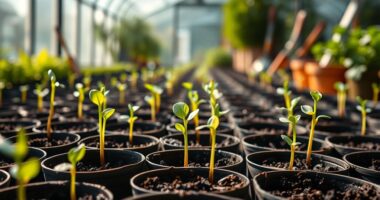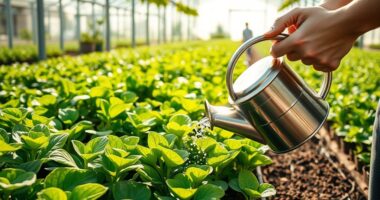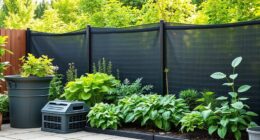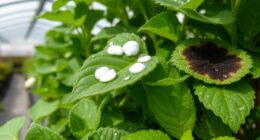A greenhouse is an enclosed structure that creates a controlled environment for growing plants. It helps you cultivate crops year-round and protects them from harsh weather, pests, and diseases. By regulating temperature and humidity, greenhouses improve the quality and yield of your produce. You can extend your growing season and reduce reliance on chemical inputs. Discover how different types of greenhouses can fit your gardening needs and enhance your gardening experience.
Key Takeaways
- A greenhouse is a controlled environment for growing plants, utilizing transparent materials to harness sunlight while shielding crops from harsh weather.
- It enhances plant growth by regulating temperature, humidity, and air circulation, leading to improved yields and produce quality.
- Greenhouses allow for year-round cultivation, stabilizing income and reducing dependency on seasonal variations in crop production.
- They minimize pest and disease incidence, reducing the need for chemical pesticides and promoting sustainable gardening practices.
- Investing in a greenhouse increases property value and provides predictable income through premium-quality crops.
Understanding the Concept of a Greenhouse

A greenhouse is a fascinating structure that plays a vital role in modern agriculture. It’s designed with transparent walls and a roof, allowing you to grow plants in a controlled environment.
The idea of greenhouses dates back to Roman times, but the modern versions emerged in 17th-century Europe. You’ll find various materials used, like glass, polycarbonate, and polyethylene film, creating everything from small cold frames to large commercial facilities.
Greenhouses protect your plants from extreme temperatures and weather conditions, ensuring they thrive. They feature frameworks made from galvanized steel or aluminum, along with ventilation systems to regulate temperature and humidity.
With a greenhouse, you can create the perfect microclimate for your plants, enhancing your gardening experience.
The Key Functions of Greenhouses

While many people appreciate the aesthetic and practical benefits of greenhouses, their key functions extend far beyond mere appeal.
Greenhouses excel at regulating temperature and managing humidity, creating ideal environments for your plants. They let in light while shielding your crops from harsh weather, pests, and diseases. This protection not only enhances plant growth but also allows you to cultivate a diverse range of species year-round.
You’ll find that the controlled climate leads to increased crop yields and better quality produce. Moreover, proper ventilation ensures a consistent supply of air for photosynthesis, promoting robust plant health.
Common Materials Used in Greenhouse Construction

Choosing the right materials for greenhouse construction is crucial for creating a successful growing environment.
For frames, aluminum is lightweight and corrosion-resistant, making it ideal for residential setups, while steel offers strength for commercial use. Wood adds aesthetic appeal but needs maintenance. Galvanized steel provides added durability with its zinc coating.
When it comes to covering materials, polyethylene film is cost-effective, while polycarbonate is versatile and impact-resistant. Glass offers excellent light transmission but can be heavy and pricey.
For a stable base, concrete works well, and aggregates ensure proper drainage.
Lastly, consider insulation options like thermal blankets or bubble wrap to maintain temperature stability. Having the right growing environment is essential for maximizing your greenhouse’s potential.
Choosing the right materials will set you up for greenhouse success.
How Environmental Control Works in a Greenhouse
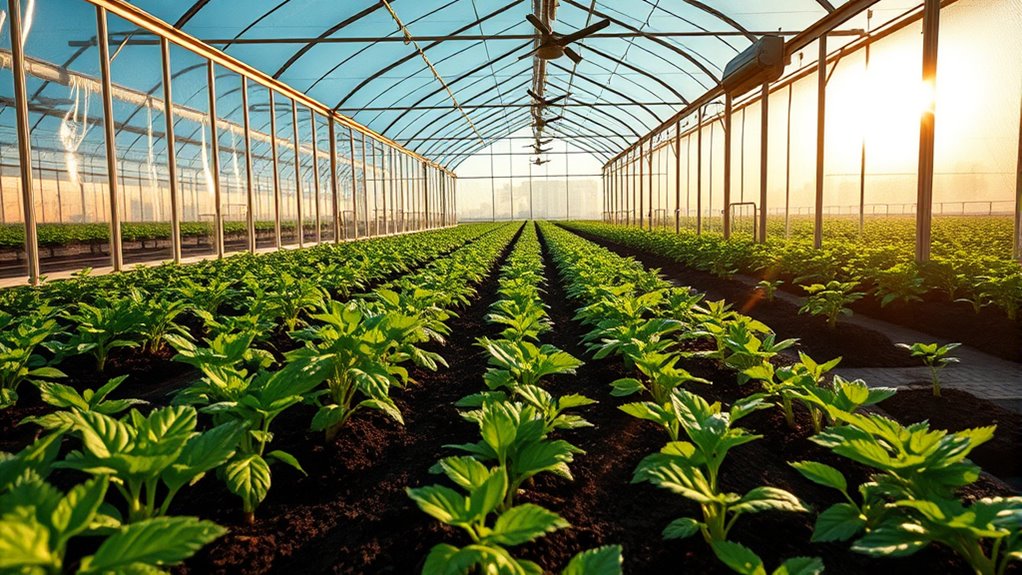
Understanding how environmental control works in a greenhouse is essential for maximizing plant growth and health. These systems automate temperature, humidity, and light adjustments, ensuring optimal conditions for your plants.
With features like CO2 enrichment and soil sensors, you can manage the environment comprehensively.
Temperature control is achieved through thermostats and heating/cooling systems, while humidistats and fogging systems regulate moisture levels.
Lighting and irrigation management enhance growth efficiency, and ventilation systems promote air circulation.
The Impact of Greenhouses on Plant Growth

Greenhouses significantly enhance plant growth by creating an environment where conditions like temperature, light, and humidity are carefully controlled.
You’ll enjoy optimized growing conditions, which lead to extended growing seasons and year-round cultivation. With these ideal settings, you can expect increased crop yields and improved crop quality compared to traditional methods.
The controlled environment also minimizes pests and diseases, reducing your reliance on pesticides. Additionally, elevated CO2 levels promote faster photosynthesis, further boosting growth rates.
By managing temperature and light effectively, greenhouses allow plants to thrive, ensuring they reach their full potential.
In essence, a greenhouse transforms your gardening experience, making it more productive and efficient, while also enhancing the quality of your plants.
Economic Benefits of Greenhouse Cultivation

While many may think of greenhouses solely as structures for growing plants, they actually offer significant economic benefits that can transform your farming approach.
With controlled environments, you can achieve increased crop yields, leading to higher revenue. Greenhouse-grown crops often fetch premium prices due to their superior quality. Plus, growing year-round stabilizes your income and shields you from market fluctuations.
Greenhouses also reduce costs, using up to 90% less water and minimizing pesticide needs. Automated systems cut labor costs while enhancing efficiency.
Investing in greenhouse infrastructure can elevate your property value, and by tapping into niche markets, you gain a competitive edge.
Ultimately, greenhouse farming can provide predictable income streams and high returns on investment.
Different Types of Greenhouses and Their Uses

There are several types of greenhouses, each designed to meet specific needs and uses.
Freestanding greenhouses offer flexibility in size and location, while attached greenhouses maximize space by connecting to existing structures. Cold-frame greenhouses protect plants from frost, extending the growing season. If you’re looking for budget-friendly options, hoop houses are easy to assemble and maintain. For a unique design, consider geodesic dome greenhouses, which provide even light distribution.
Materials also vary; glass offers excellent light but is costly, while polycarbonate and aluminum are durable and economical.
If you’re into specialized cultivation, nursery greenhouses focus on seedlings, and hydroponic greenhouses use water solutions for efficient growth. Each type serves distinct purposes, making them valuable for any gardener.
Greenhouses in Research and Education

In the realm of research and education, the use of greenhouses transforms learning and experimentation, allowing students and researchers to engage with plant biology in dynamic ways.
These controlled environments utilize advanced technologies to regulate temperature, humidity, and light, ensuring optimal conditions for plant growth. You can monitor and manage greenhouse conditions remotely, enhancing your data collection efforts.
Greenhouses also support hands-on learning, offering year-round educational opportunities regardless of weather conditions. With customizable sections, you can simulate diverse environmental conditions, fostering interdisciplinary studies that bridge biology, physics, and environmental science.
Plus, they serve as community resources for workshops and events, enriching the educational experience for everyone involved.
Sustainable Practices in Greenhouse Gardening

How can sustainable practices enhance your greenhouse gardening experience?
By incorporating eco-friendly materials like reclaimed wood and bamboo frameworks, you reduce waste and promote sustainability. Additionally, using natural building materials can further enhance the structural integrity of your greenhouse.
Using recycled plastic panels and polycarbonate glazing improves insulation while minimizing environmental impact.
Optimize your greenhouse’s energy efficiency by positioning it for maximum sunlight and utilizing passive solar design.
Implement rainwater harvesting and drip irrigation systems to conserve water, ensuring your plants thrive without excess waste.
Embrace composting and organic fertilizers for healthier soil, and consider integrated pest management to maintain a balanced ecosystem. Incorporating organic fertilizers can significantly enhance soil health and plant growth.
Lastly, explore innovative technologies like smart greenhouse systems and vertical farming to maximize space and efficiency. These sustainable practices not only benefit your garden but also contribute positively to the environment.
Frequently Asked Questions
How Much Does It Cost to Build a Greenhouse?
You’d think building a greenhouse is a budget-friendly venture, but brace yourself! Costs can range widely.
A small greenhouse might set you back between $1,000 and $7,000, while mid-sized ones go for $1,500 to $9,000.
Larger structures? They can balloon to $18,000!
If you’re feeling crafty, DIY can save you some cash, but don’t forget about materials and local regulations—they love to add to your expenses!
What Plants Thrive Best in a Greenhouse Environment?
In a greenhouse, you can grow a variety of plants that thrive in controlled conditions.
Consider adding tomatoes and peppers for year-round harvests, or cucumbers and aubergines for their warmth-loving nature.
Strawberries and blueberries flourish with the right soil.
For unique options, try cucamelons or luffas.
If you’re into flowers, pansies and geraniums can brighten your space all year long.
Embrace the possibilities to enhance your gardening experience!
Can I Use a Greenhouse in Winter?
Imagine a cozy cabin in a snowstorm, sheltering you from the cold.
That’s what a greenhouse does for your plants in winter. You can absolutely use a greenhouse during this season! It protects your plants from freezing temperatures, allowing you to grow a variety of crops like leafy greens and root vegetables.
With the right insulation and heating, your greenhouse becomes a thriving oasis, ensuring your gardening passion doesn’t hibernate with the cold.
How Often Should I Water Plants in a Greenhouse?
You should water your plants in a greenhouse based on their specific needs.
Generally, check the soil moisture regularly and adjust your watering frequency according to environmental conditions. In warmer months, you might need to water daily, while cooler months may require less frequent watering.
Always aim for deep watering, ensuring the soil is saturated but avoid overwatering to prevent root rot.
Use moisture meters for accurate readings to help you decide.
What Pests Are Common in Greenhouses?
You walk into your greenhouse, and something feels off. Pests could be lurking, ready to wreak havoc.
Common culprits include aphids, whiteflies, and thrips, all eager to feast on your plants. Fungus gnats may hover around the soil, while mites silently damage your crops.
Don’t underestimate slugs and caterpillars either; they can be sneaky. Keep an eye out and act swiftly to protect your precious plants from these unwelcome visitors!
Conclusion
In a world where your plants can thrive like stars in a clear night sky, a greenhouse becomes your sanctuary. It’s not just a structure; it’s a gateway to lush growth, economic gain, and sustainable practices. By harnessing the power of controlled environments, you can cultivate vibrant gardens year-round. Investing in a greenhouse means embracing a new realm of possibilities for your gardening journey, turning your green dreams into a flourishing reality.




